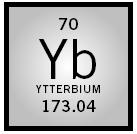Ytterbium

MELTING POINT:
824°C
BOILING POINT:
1,196°C
DENSITY:
6.98 g/cm
3
MOST COMMON IONS:
Yb(III)
Ytterbium was discovered by the Swiss chemist Jean Charles Galissard de Marignac in 1878 and named after the town of Ytterby, in Sweden (the site of the discovery of the ore with which de Marignac worked). Its primary source is xenotime and monazite ores, which are mixtures of rare earth orthophosphates. In the earth, ytterbium is more abundant than tin. Ytterbium has been found in meteorites, in lunar rock samples, and to a small extent in the oceans.
At room temperature the element is a silvery metal . Its ground state electronic configuration is Xe 6 s 2 4 f 14 . Ytterbium has many stable isotopes : 168 Yb, from 170 Yb through 174 Yb, and 176 Yb. Unstable synthetic isotopes have been produced: from 151 Yb through 167 Yb, as well as 169 Yb and 175 Yb. Yb(III) compounds, as solids and in solution, are colorless.
Ytterbium has no known biological function or toxicity. The metal has been used to improve the strength and mechanical properties of stainless steel. Ytterbium also finds use in fiber amplifiers and fiber optic technologies. Its single absorption band in the infrared at 985 nanometers (3.88 × 10 −5 inches) has made it useful in silicon photocells that convert radiant energy directly into electrical energy. In the laboratory, chemists usually start with Yb 2 O 3 to make other compounds.
Herbert B. Silber
Bibliography
Cotton, F. Albert, and Wilkinson, Geoffrey (1988). Advanced Inorganic Chemistry , 5th edition. New York: Wiley.
Cotton, Simon (1991). Lanthanides and Actinides. New York: Oxford University Press.
Comment about this article, ask questions, or add new information about this topic: